Obsolescence
december 29, 2010.
One of the undisputed highlights of Obsolescence in the Parisian La Générale between December 17th and 19th was a gramophone record pressed into ice by Blenno Wurstbrücke. In the picture you see how Blenno carefully lowers the needle of his record player onto the icy grooves of this fine piece of frozen media. It then crackled its way around and cut its way through, while the ice slowly liquefied.
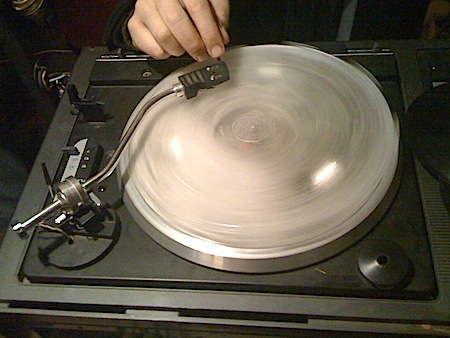
Blenno's disque de glace was a perfect metaphor for the three
days in which the icy cold La Générale Nord-Est (the place
you may remember from a number of other remarkable events, like this summer's
Yi Sang à
Paris) hosted a mini-festival dedicated to the old and the new means
that we use to record and store our texts, images, sounds, thoughts, dreams
and visions.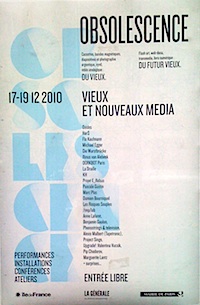 Yes, all these media and storage formats of which obsolescence
is the middle name.
Yes, all these media and storage formats of which obsolescence
is the middle name.
Inspired by last month's K7-evening
at the Eindhoven STRP-Festival, where I learned the name of the inventor
of the audio cassette and the CD, I had decided to do a silent, continuous,
projection of one single image onto a wall of La Générale,
for the full three days of Obsolescence: the one (small and of
very lo resolution) picture
that I had found on the web of the inventor of these 2 media, one obsolete
already and the other soon to become, both of which had an enormous impact
on the way in which we consumed (as well as produced and distributed) music
over the past handful of decades. And Rébus had the perfect - obsolete
- method for realizing this projection: an overhead
projector. In French this appareil is called a rétroprojecteur,
whence my contribution to Obsolescence consisted in a retro
projection of a blow-up of this photograph of De Ingenieur
("l'Ingénieur/The Engineer"), which I had copied in black-and-white onto
a
transparency.
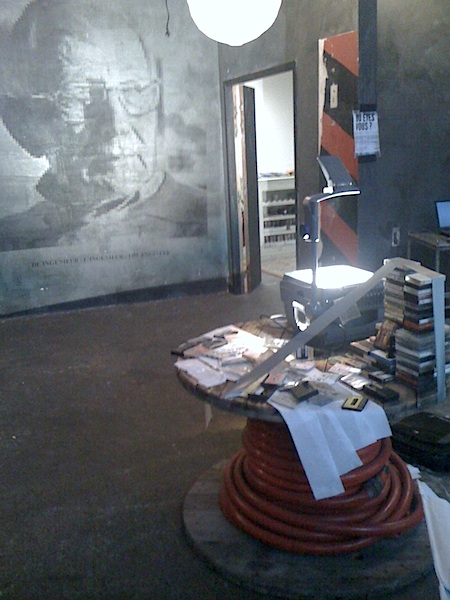 |
I intended De Ingenieur to be modest, gentle & quiet but communicative. My presence during most of the time of its showing was part of the piece:
each time I'd see visitors lingering at the
the side of the projector, looking at the picture, and wondering who the old guy would be, I would step up to them and tell the story of ir. Lou Ottens,
the inventor of the cassette and the CD.
The projection of
the engineer's picture also incited visitors, who discovered or rediscovered the functioning of the rétroprojecteur,
to add things to the image by posing objects on the transparency. Thus over the three days the projection remained in a state of ongoing
transformation.
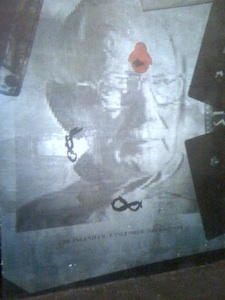 |
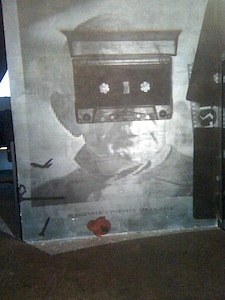 |
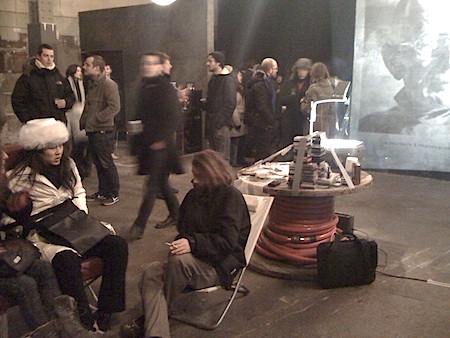 |
|
For as long (or short) as it will be deemed a history worth recounting, the official historiography of 20th century audio technology is likely stick to the largely anonymous version, in which short-lived popular media like the cassette and the CD are linked to the multinational corporations (in casu Philips) that developed and marketed them. It therefore is quite likely that the engineer's name, as that of the person who was responsible for their coming into being, will remain anecdotical, a mere footnote at the most. So, yes, there was something of a 'resistance' about the installation, a word that could be read on the wall late sunday evening, after I had packed the engineer's transparency and readied myself to step out back into the avenue Parmentier and head home. There was something of a 'resistance' of course about many of the contributions to Obsolescence, especially those that centered around the continuing use or re-use, of equipment and media formats that have become obsolete, other than for 'artistic' and/or expository/educational purposes. 'Resistance', that is, against the ever shorter cycles of successive technological innovations that are driven mainly by market mechanisms, and but little by necessity or demand. We have gotten used to this fact. We learned to accept that the smart phone we got for Xmas and now are drooling all over, will have become obsolete this time around next year. I now know for a fact that the 24/7 use that I make of my MacBook will burn it out and render it un-usable in little more than two years from the date of its purchase. User/producer technology is not made to last. It is made to be cast away and replaced.
So something somehow somewhere must have gone very wrong. For how then can it be possible that I still love my iPhone the way that I do? (And I do...)
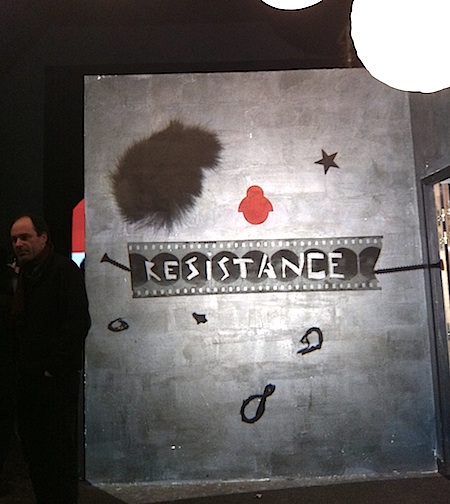 |
There was an awful lot to be heard and seen those three days at La Générale, and images and sounds were cast around and
projected in a great many ways, from all sorts of plastics and tapes running on all sorts of machines, be it in analog or digital form.
Flo Kaufmann and Michael
Egger had come over from Switzerland to demonstrate their work on realtime
analog video processing, that I already had become somewhat acquainted with
during the Shift
Festival in Basel. It's great work they are doing, and I do hope that
we'll have another - & preferably warmer occasion - to combine Flo &
Michael's video live with, for example, the sounds of Diktat.
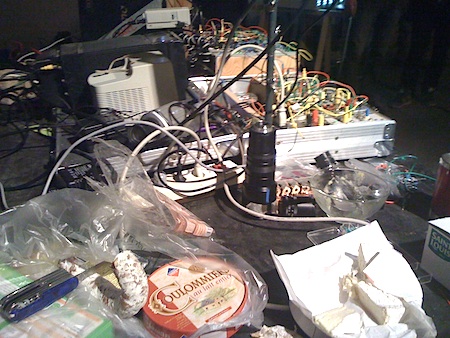
The Project Singe presented their Monkey-Party DVD as an installation. Though I never actually had a chance to see it, I knew about the Project Singe's DVD. It provides an interesting example of sort of a 'synchronicity', as Monkey Party actually was developed and released around the same time that with the ookoi we did the 1024 DVD. And though they are very different, both projects originate from a similar spirit and curiosity in looking for the limits of the technical possibilities of the DVD format. Both make extensive use of random functions for the presentation of its content, and use the DVD format as a means to create an 'audiovisual installation' at home.
The collective La Draille showed their web documentary Villageplanetaire (documenting the daily life in the tiny hamlet of Rieisse in the south of France). They also set up 'Révolution(s)', an interactive video installation involving panorama's filmed in Nepal early 2008, the projections of which could be activated by the visitors by turning a Tibetan prayer wheel.
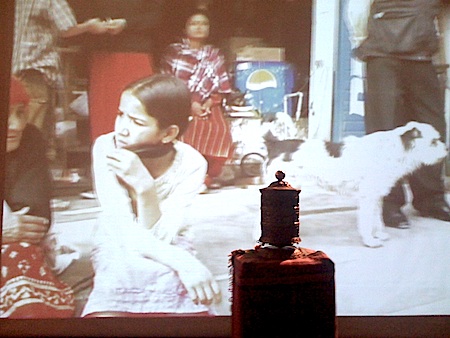
According to Rébus, the event's tireless organizer, the impressive mass of works, performances and presentations during the days of Obsolescence at La Générale had come together pretty much haphazardly and largely all by itself. Despite firm warnings for the inhospitable temperature of the unheated La Générale during this time of the year and the zero budget, there were far more contributions proposed than these three days could accommodate for.
What made the event especially worthwhile, is the very
broad range of media and formats that one encountered in the performances
and presentations: from the very old to the spectacularly new. And it may
surprise you, but what I now think of as the highlights,
resided mainly in the corner of the 'spectacularly new' or 're-new'.
Though from a musical point of view the result was yet little
exciting, I liked very much the principle of friday evening's 'brain
wave battle' between Pascale and Ursula, custom-scripted by Sam. It
made me think of the lyrics to Mary & Jane, which was one of
our 1980s Young
Lions' 'cult hit'-songs. It might have served as a motto
for the performance:
"If we compare two things in order to see the difference between
them, we separate Mary & Jane from others. If we contrast Mary's behavior with that of Jane, we see that Mary is much kinder.
We got to draw the line somewhere."
Thus the following lines originating from Pascale's and Ursula's 'brain waves' were drawn during
the duo's battle/performance at La Générale:
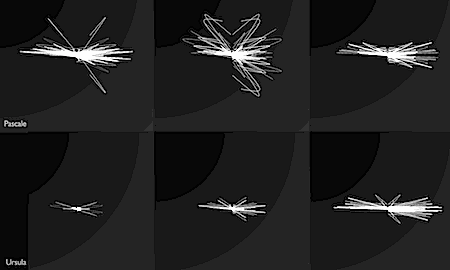
The musically most captivating and convincing of the Obsolescence performances
that I attended was also on friday evening, when Damien
Bourniquel embarked upon a live mash/glitch/data mosh of a selection of uTube music clips and the live playing
of a guitarist (whose name I hope someone reading this soon will let me know ...) There's a picture of Daniel's 'data mosh' projection at the
end of this entry.
And I was most impressed by Etienne Mineur's presentation (opening saturday evening's Dorkbot session). Etienne introduced
the projects of the Editions
Volumiques', which in a playful and imaginative manner investigate possible futures for
the book in a 'post internet and network media revolution' age.
...
I have myself always considered it best to just throw the whole chaotic media mess together. Any media/format is a valid means, as long as it leads to some set - or why not even shifting? - goal... Does that make me cross- or transmediaready, as visitors were urged to become in what maybe was the weekend's most mysterious, though utterly global, contribution?
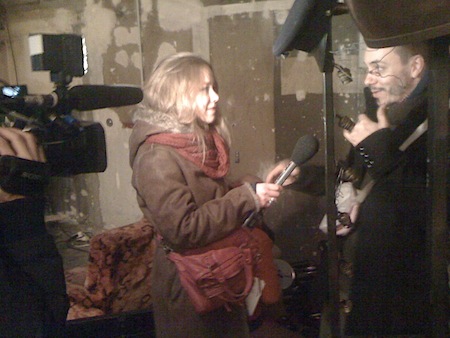
...
The number of artists/musicians working in some way or other with audio/visual media and formats from the recent past has been steadily increasing over the past couple of years. Often their performances though have trouble reaching beyond being a mishmash of nostalgia inducing demonstrations of gadgetry and equipmental glitch-driven random stuff, without any apparent other intention or subject than the media-materiality's past tense. However amusing and entertaining such back to the future's can be, personally I long for a more thorough investigation, and a use of the many peculiarities of these 'old' machines and the sonic/visual properties of the corresponding analog media formats as a means to a goal, rather than as a goal in and by itself.
The old media carriers and machines are great to watch, though, in whatever way they are put to use.
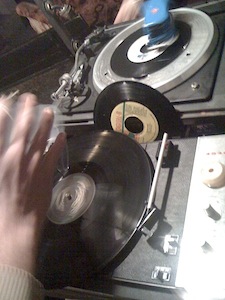
|
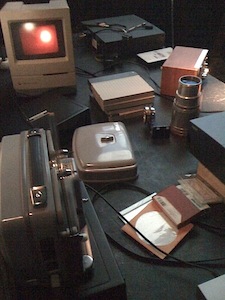 |
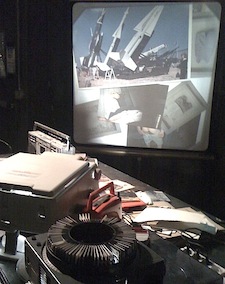 |
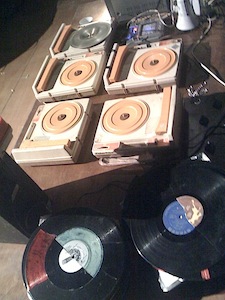 |
...
Overlooking the (short) history of media formats and the currently almost fully accomplished (r)evolution of main stream technology that has made digital treatment and storage the norm, it is remarkable how, together with the ever increasing power and versatility of the ubiquitous means for producing and consuming audio-visual materials, the storage of the data that represent all of this content is becoming ever more invisible, ever more discreet. The final results and documentation of almost all of my current productions, as well as most of the music that I listen to, the pictures I take, many of the books or texts that I read and the films that I watch, reside on hard drives that do their utmost to stay hidden and unnoticed. They are stuck inside increasingly flat and invisible portable computers or inside small plastic boxes kept out of sight somewhere underneath my table. And - increasingly - data are becoming part of the network of networks. Such data do not even have a physical storage space anywhere near me.
Specialized physical carriers for content of certain types (like old tapes, vinyl records, minidiscs ... for music; floppy disks, zip discs ... for software and other digital files; 8/16/35 mm celluloid, etc... for film, images) have all but disappeared. We no longer need them the way we used to. Nor do we have any more need for much of the mechanics, the visually - and often also aurally - imposing machines that until not so very long ago had to be used for storing and accessing our media content.
It was the very visibility of the avalanche of early media-technological advances that in the second half of last century gave a clear and popular public face to our future, through extrapolation of technology's architecture and its looks. Nowadays, technology's increasing power is packed into ever smaller, ever flatter, ever planer, objects with hardly any more moving parts and but the simplest of possible interfaces. Like a mere surface that one may swipe, pinch or tap... While all of this technology within not even a wink of our history's eye became an inextricable part of our lives and continues to pervade the very hearts of our culture, the machines that carry the technologies tend to become un-present. They are striving to - and eventually indeed will - dissolve.
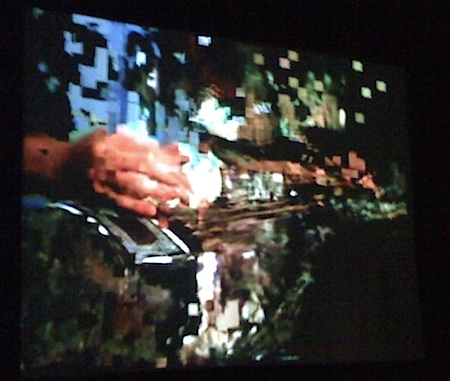
I can see that future: a future in which all machines are obsolete. I stand in awe before it. Be it good or be it evil, it is a future that is essentially faceless.
It no longer has that look.
...
tags: media, Paris, La Générale
# .399.
comments for Obsolescence ::
|
Comments are disabled |
SoundBlog entries around and about La Générale Nord-Est:
(2024, march 9) - Orlando & Artaud wed bound at La Générale, even
(2022, september 2) - Three Musketeers Musicking Maastricht & La Générale
(2022, july 2) - X-unPub
(2021, june 13) - Die Stillgestandenen (The Stillstands / Standstills / Stillstanders)
(2021, february 21) - Lento (slowly)
(2018, september 01) - t'Obsolete or not t'Obsolete ... [part iv]
(2018, august 13) - Rage, rafts & refugees
(2018, august 10) - t'Obsolete or not t'Obsolete ... [part iii]
(2018, july 21) - t'Obsolete or not t'Obsolete... [part ii]
(2018, april 10) - La Générale Nord-Est (PAMP18-1)
(2017, august 19) - t'Obsolete or not t'Obsolete ... [part i]
(2016, august 04) - Nicolas Collins - 2 April 2016, La Générale
(2015, july 15) - Bridges, troubles, water - unPublic #19
(2014, april 08) - La physicalité du son. Tome 1.
(2013, december 13) - Candles, Cassettes & Champagne - unPublic #4
(2010, december 29) - Obsolescence
(2010, august 14) - "And what about Yi Sang?" (이상 à Paris [iv])
(2010, june 29) - Ceremonies (Yi Sang 이상 à Paris [iii])
(2010, june 25) - Read me a poem, Yi Sang! (Yi Sang 이상 à Paris [ii])
(2010, june 13) - Yi Sang 이상 à Paris [i]
(2010, january 13) - Art fleas (puces de l'art)
(2009, july 20) - General Acoustics
(2006, august 14) - placard : la générale (Belleville)